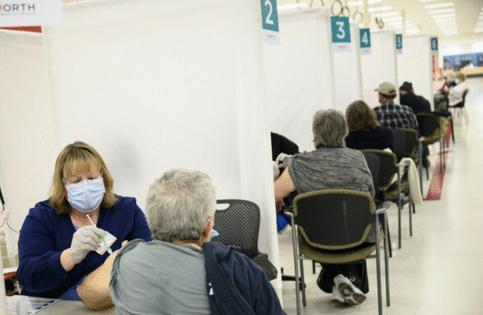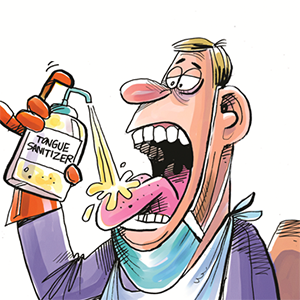Minnesota health insurers warn of 'dire' premium spikes, lost coverage in 2026
Published in Health & Fitness
Chief executives at Minnesota’s four largest nonprofit health insurers are warning premiums could spike and thousands of residents could lose coverage in 2026 if the state’s congressional delegation doesn’t help save enhanced federal tax credits that subsidize coverage bought through the public MNsure exchange.
The extra federal subsidies are set to expire at the end of next year, which will coincide with the end of state funding for a different program that also controls costs for people shopping in the individual market through a mechanism called reinsurance.
As a result, premiums could jump 55% and about 93,000 Minnesotans could lose coverage in 2026, according to a study commissioned by the health insurers that was published earlier this year. The impact would come solely in the individual market, where roughly 3% of state residents buy coverage from private health plans governed by the Affordable Care Act.
“Losing enhanced tax credits and the state reinsurance program at the same time would have a compounding and dire effect on the cost of health insurance in the state and the number of Minnesotans who would lose health insurance coverage,” the CEOs of Blue Cross and Blue Shield of Minnesota, HealthPartners, Medica and UCare wrote lawmakers on Nov. 7. An October letter to Gov. Tim Walz from the Minnesota Council of Health Plans, the trade group for these insurers, asserted “this ‘double whammy’ will result in a record number of Minnesotans losing coverage.”
The extra tax credit dollars first became available through federal stimulus legislation passed in 2021. The subsidies were then extended through the end of next year by the federal Inflation Reduction Act of 2022, which also is adding to medication benefits in Medicare health plans and letting the government negotiate prices on a limited number of drugs.
Meanwhile, in 2018 Minnesota implemented its reinsurance program, which has been credited with reducing premiums by about 15% to 20% per year in the individual market.
Both programs are focused on a slice of the health insurance market that’s received a tremendous amount of attention from politicians and policymakers over the past decade. This is the “Obamacare” market, including MNsure in Minnesota, where people under age 65 who are self-employed, don’t receive job-based benefits, or have too much income for the state’s MinnesotaCare program can buy subsidized coverage.
About 186,000 people in Minnesota this year were insured through the individual market, including 134,000 who bought health plans via MNsure, where many tap federal tax credits to discount premium costs. Of the MNsure enrollees, tens of thousands of people would see their costs go up, the state agency says, if the enhanced federal tax credits expire at the end of 2025.
For eligible households, the average monthly premium after tax credits is expected to increase by about $170 per month, MNsure says, to $481 monthly. Plus, an estimated 18,600 MNsure enrollees would lose access to financial help altogether.
ACA tax credits are awarded based on a complicated formula that compares an individual’s income with the monthly cost for the “benchmark” health plan being sold in their county. The law stipulates that people pay no more than a fixed percentage of their annual earnings on the premium for the benchmark health plan.
Since 2021, the federal enhancements reduced the prices consumers pay at different income levels. They also expanded access by eliminating an income-based eligibility cap.
Support from GOP?
The administration of President-elect Donald Trump has not specified its plans for the enhanced tax credits.
“President Trump delivered on his promise to protect Social Security and Medicare in his first term, and President Trump will continue to strongly protect Social Security and Medicare in his second term,” spokeswoman Karoline Leavitt said in a statement.
There’s speculation, however, that Trump and Congressional Republicans won’t extend the extra ACA subsidies, but instead use the savings to help fund tax cuts.
“I think the progressive enhancements that occurred during the the Biden years will be allowed to expire,” said Larry Jacobs, a political science professor at the University of Minnesota.
The Minnesota Star Tribune contacted members of the state’s Congressional delegation this week on the issue. As of Thursday morning, three DFLers — Sen. Amy Klobuchar and Reps. Angie Craig and Ilhan Omar — said they supported extending the extra subsidies.
“I believe those numbers they laid out there,” Klobuchar said of the letter from the insurance company CEOs. Of Republicans, she said: “They know that this would be a jolt to the market.”
Reinsurance has worked to control consumer costs by giving health insurers taxpayer-funded reimbursement for high-cost medical claims incurred by people in the individual market. Back in 2017, the idea was championed by state Senate Republicans and implemented by former DFL Gov. Mark Dayton to rescue an insurance market where premiums were spiking and health insurers were threatening to drop out.
The program operates through an agreement with the federal government that provides partial funding, and the current authorization runs through the end of 2027. But the state government has provided funds for the program only through the end of next year.
Sen. Gary Dahms, a Republican from Redwood Falls, predicted his party would make extended funding for reinsurance a priority in the coming legislative session.
“It’s accomplished what needed to be accomplished and has bipartisan support,” Dahms said. “The program is in place, the program is working and everybody knows how to deal with it.”
Jacobs, however, said he had doubts that Republicans in the state House, who will newly be sharing power next year with the DFL, will back the idea since some deride reinsurance as a handout to health insurers. Twila Brase, executive director of the conservative Citizens’ Council for Health Freedom, said her group has never liked the program because “rather than the premium dollars coming out of your front pocket where you can see it, they’re coming out of your back pocket where you can’t see it.”
Insurers, however, stress the benefits for consumers. Eagan-based Blue Cross, for example, is increasing individual market premiums an average of 11.6% next year, but the company says the increase without reinsurance would be in excess of 30%.
Dimming prospects for a public option
Some DFLers, meanwhile, had been hoping to advance a “public option” in the individual market, where consumers shopping via MNsure would have the chance to buy into the state’s MinnesotaCare program. The coverage is available to state residents who make too much for the state-federal Medicaid program, such as single adults with incomes between roughly $20,000 and $30,000.
Megan Paul, 30, of Richfield has been pinning her hopes on the idea. She previously qualified for MinnesotaCare, but no longer qualifies and now struggles with unaffordable requirements for out-of-pocket spending with private coverage via MNsure.
“It’s a disaster,” Paul said.
But even with control of both state legislative chambers, the DFL last session couldn’t advance legislation to fund the public option. The state had been pursuing a model that would have tapped federal funding, but this now would require approval from the Trump Administration — which is “likely going to be less favorable,” said Rep. Jamie Long, DFL-Minneapolis.
Long, who sponsored public-option legislation in the House, said supporters are considering next steps following the election results. Like Long, Sen. Melissa Wiklund, DFL-Bloomington, still supports the idea, but said the near-term prospects have been diminished, particularly as lawmakers confront more immediate questions about reinsurance and the enhanced ACA tax credits.
Jacobs offered a more blunt assessment, given Trump’s victory over Democrat Kamala Harris:
“It has no chance,” he said of the public option. “If the DFL had maintained its majority in the [state] House, and Harris had been elected, then I think you’d say: OK, well, this is still in active consideration. But we’re in an entirely new political environment. ... It’s hard to see another opening for progressive health reform for some time.”
©2024 The Minnesota Star Tribune. Visit at startribune.com. Distributed by Tribune Content Agency, LLC.










Comments